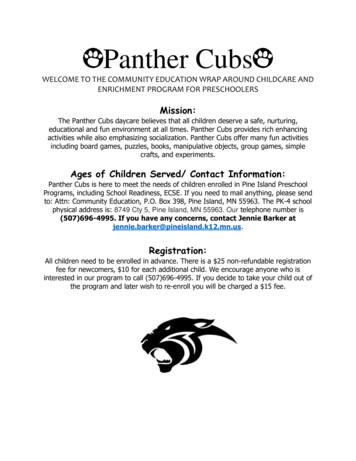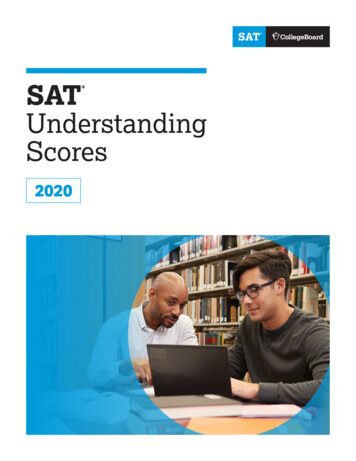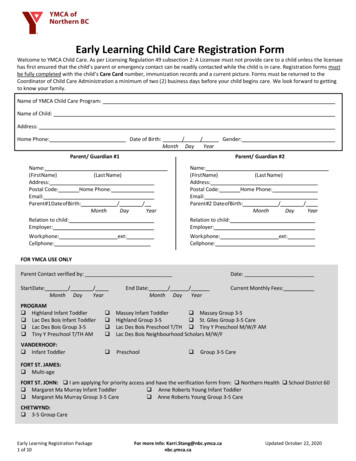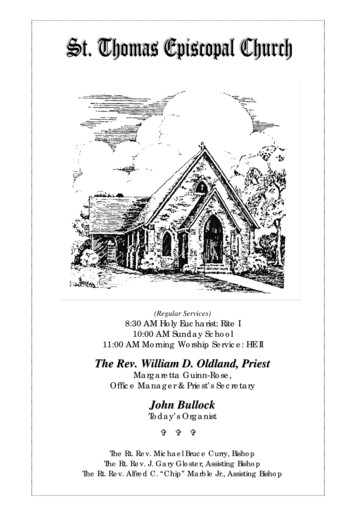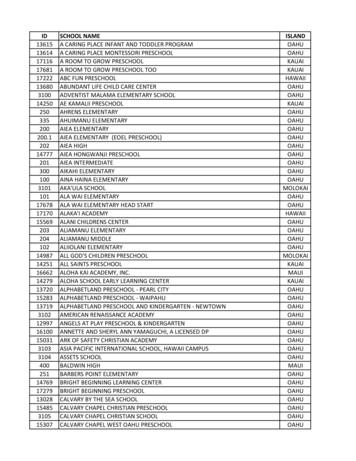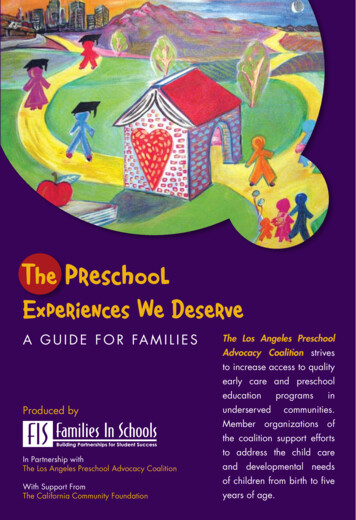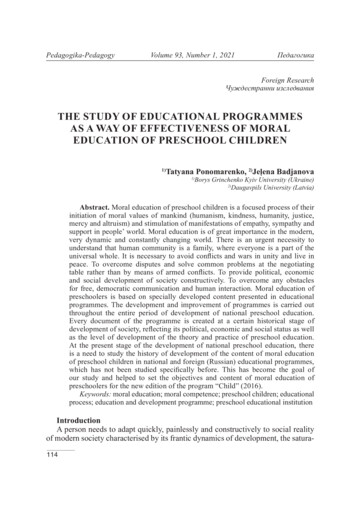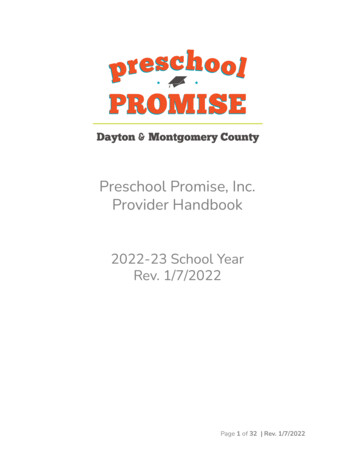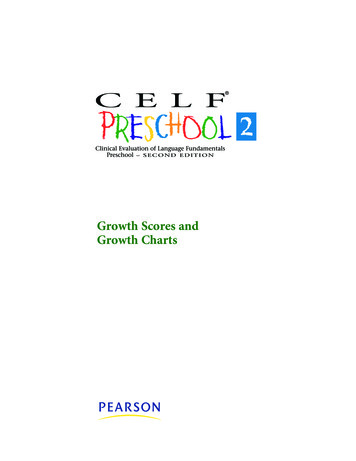
Transcription
Growth Scores andGrowth Charts
Growth ScoresGrowth scores provide an equal interval scale from which you can quantify small improvements in the language skills of a child with a moderate to severe language impairment.CELF Preschool–2 provides growth scores for each subtest that provides a scaled score,with the exception of Word Classes–Total.* You can use growth scores for the followingpurposes: Track a child’s language skills development from age 3 through 6, Determine if the child has mastered additional language skills sincea previous administration of CELF Preschool–2, and/or Measure the efficacy of an intervention program that has beenimplemented for a child.The advantage of using growth scores rather than scaled scores to assess improvement ina child’s language ability is that growth scores provide a quantifiable measure of a child’sgains in language ability, even if the amount of change is small. That is, growth scoresprovide an estimate of language ability independent of a child’s peer group. The scoresincrease as the child demonstrates new abilities. In comparison, scaled scores provideinformation about a child relative to his or her peers at a given time, so his or her scaledscores may remain relatively unchanged; as the child gains new language skills, his peersare also gaining new language skills.Developing Growth ScoresGrowth scores were derived for each subtest by mapping the raw scores to correspondinggrowth scores using an item response theory (IRT) model (Hambleton, Swaminathan, &Rogers, 1991). Winsteps 3.31 (Linacre, 2005) was used to calculate ability scores (thetas)according to the 1-parameter logistic model. These ability scores were then rescaled toform the growth scores, with a range of 100–900, a theoretical mean of 500, and a standarddeviation of 100 for each subtest.*Note. Item-level scores are the foundation of item response theory (IRT) analysis, the basis of growth scores;because Word Classes–Total does not have item-level scores, growth scores cannot be generated.Hambleton,. R. K. H., Swaminathan, H., & Rogers, H. J. (1991).Fundamentals of item response theory. Newbury Park, CA: Sage.Linacre, J. M. (2005). WINSTEPS Rasch measurement computer program.Chicago: Winsteps.com2Copyright 2009 NCS Pearson, Inc. All rights reserved.
Interpreting Growth ScoresYou can record the growth score from the first administration of CELF Preschool–2 on thegrowth chart. This allows you to compare the child’s language development against thoseof children who are developing language typically. As you complete successive assessments,you can record the growth scores for each test administration on the same growth chart.This enables you to compare scores and examine changes between assessments. Whencomparing the scores from two administrations, three patterns are possible: the growthscore from the test administered most recently increases, is approximately the same, ordecreases.Scores IncreaseIn some cases, you will find that the growth scores increase across repeated testing sessions.Growth scores increase when the child earns additional raw score points on a subtest.Score increases, even small increases, can usually be attributed to refinement or mastery oflanguage skills that the child did not demonstrate during the previous test administration.However, when interpreting the results of testing, keep in mind that there are reasons otherthan mastery of additional language skills for an increase in raw scores. The child could have been shy, sick, tired, distracted, or frustrated during the first testadministration and did not perform at his or her best, so the earlier test results maynot have reflected the child’s true language skills. The child might have guessed the correct response to one or more multiple-choicetest items, which would result in a higher raw score.Scores Stay About the SameSometimes a child’s growth score changes very little. Possible reasons include: The child may have been tested too soon after the previous test administration tohave experienced change. That is, the child may not have been receiving services for asufficient length of time for change to occur as a result of intervention (e.g., the childis only in the fourth week of an eight-week intervention program). The child might be experiencing a developmental plateau for certain types of language skills, which is not uncommon for children to encounter at some points alongthe developmental continuum. When this is the case, you may not see progress forcertain types of skills. For example, acquisition of morphological markers does notproceed at a continuous pace. If the child’s difficulties are primarily in acquiringmorphological markers, he or she may be tested at an age at which there are noCELF Preschool–2 items to capture morphological development.Scores DecreaseIn some cases, growth scores decrease from previous testing for a variety of reasons. The child may be sick, tired, frustrated, or distracted during the second test session.In which case, the child is not demonstrating a best performance, and it would beerroneous to interpret a lower score as evidence that the child is losing languageskills.Copyright 2009 NCS Pearson, Inc. All rights reserved.3
Declining growth scores may reflect the characteristics of a disorder exhibited bythe child. For example, some children identified with autism spectrum disorder maymaster early language milestones (e.g., learn to say their first words at 12–15 months)but then regress (e.g., may stop talking). The child may have a progressive or degenerative condition in which he or she losespreviously acquired language skills. A child who has suffered a traumatic event (e.g.,head injury) or illness (e.g., meningitis or sudden onset of a seizure disorder) mayalso lose language skills previously acquired.Recording Growth Scores and PlottingGrowth ChartsThe growth table and growth charts included may be downloaded for you to use to convertsubtest raw scores to growth scores. The growth charts depict growth curves of the childrenincluded in the CELF Preschool–2 normative sample. The growth charts provide a visualrepresentation of the child’s language abilities, in reference to percentile rank, that may behelpful when reporting progress to parents.Step 1. Completing the Demographic InformationSelect the appropriate growth chart for the selected subtest. Complete the child’s demographic information (i.e., name, sex), test date, and the child’s chronological age at the timeof testing.Step 2. Converting Subtest Raw Score to Growth ScoreRefer to the growth score table to convert a subtest raw score to a growth score. Locate thechild’s subtest raw score in the columns on either side of the table. Read across the rowto the growth score in the corresponding subtest column. Record the growth score in thespace labeled Growth Score on the growth chart.Step 3. Plotting Growth ScoresYou can plot growth scores on the growth chart. Locate the child’s age along the horizontalaxis and read up the column to the corresponding growth score. Place an X at the pointwhere the child’s age and growth score intersect.Note. Each point on the horizontal axis (Child’s age) corresponds with a 6-month agerange, reflecting how the sample data were collected. For example, the first point on thehorizontal axis represents the age range 3:0–3:5, the second point represents the age range3:6–3:11, and the last point represents the age range 6:6–6:11. The child’s score can only beplotted for that age range as a discrete point. That is, if a child is age 3 years 4 months, plotthe child’s score referencing the first point (representing 3:0–3:5) on the horizontal axis.Do not plot the child’s score based on a hypothetical location between the first point (representing 3:0–3:5) and second point (representing 3:6–3:11). See the following figure for anexample of a completed growth chart.4Copyright 2009 NCS Pearson, Inc. All rights reserved.
Recalling SentencesGrowth ChartName:Child ZSex:FMGradePKSchoolSchool ZTest Date:3/04/08Age4:0Growth Score366Test Date:10/10/08Age4:8Growth Score402Test Date:6/05/09Age5:4Growth Score456AgeTest Date:Growth Score900850800750700650Growth 0–6:56:6–6:11AgeCompleted Growth ChartCopyright 2009 NCS Pearson, Inc. All rights reserved.5
Case StudyChild A, Female, Age 6 years 9 monthsChild A is a first grader who is diagnosed with a moderate language disorder. She isreceiving speech-language services from her school SLP. In addition, Child A’s parentspay for her to receive therapy from a SLP in private practice. Child A’s parents’ medicalinsurance company is requesting evidence to support Child A’s continued need for speechlanguage therapy and that her language skills are improving.Background InformationThe following background information was gathered from available reports and conversations with Child A’s parents and teacher.Family: Child A lives with both her parents and 4-year-old brother. Child A’s father is acomputer programmer. Her mother does not work outside of the home.Health and development: Child A’s mother reports a normal pregnancy and delivery.Child A was a healthy baby and continues to enjoy good health. She achieved developmental milestones during expected time frames, except for speech and language. Child A spokeher first word at age 3 years.School: Child A began preschool when she was 4 years old. Upon entering preschool,Child A was diagnosed with a language delay and began receiving speech and languageservices. Currently in first grade, she continues to receive speech and language services inschool. She is also receiving speech and language services from an SLP in private practice.Her teacher reports that Child A struggles to perform at the same level as her classmates,but she is making slow, steady progress.Current Assessment ProceduresChild A was administered CELF Preschool–2 on April 19, 2009.Level 1. Determining if There is a DisorderChild A’s Core Language score is 77 (confidence interval is 68 to 86 at 90% level), andthe percentile rank is 6. This indicates performance in the low range (confidence intervalscores range from very low to average).Level 2. Describing the Nature of the DisorderChild A’s Receptive Language index score of 69 (confidence interval of 60 to 78), with apercentile rank of 2, is in the very low range of performance (confidence interval range isvery low to borderline). Child A’s Expressive Language index score of 75 (confidence levelof 68 to 82), with a percentile rank of 5, is in the low range of performance (confidenceinterval range is very low to borderline). The difference of 6 points between the ReceptiveLanguage and Expressive Language index scores is not significant.Child A’s Language Content index score of 69 (confidence interval of 62 to 76), with a percentile rank of 2, is in the very low range of performance (confidence interval range is verylow to low). Child A’s Language Structure index score of 73 (confidence level of 65 to 81),with a percentile rank of 4, is in the low range of performance (confidence interval range isvery low to borderline). The four-point difference between the Language Content and Language Structure index scores is not significant.6Copyright 2009 NCS Pearson, Inc. All rights reserved.
Level 4. Evaluating Language in ContextBoth Child A’s parents and classroom teacher completed the Pragmatics Profile. Child A’sscore of 78 on the Pragmatics Profile met the criterion of 72. However, Child A’s parentsand teacher have concerns about her reluctance to express her ideas. Child A knows thatshe has difficulty producing longer complex grammatical sentences, so she often does notparticipate in class discussions. In addition, Child A frequently misunderstands instructions but is hesitant to ask for help when she is confused.Nonstandardized Assessment ProceduresInterview with parents: Child A’s parents report that she is in her third year of speechlanguage therapy (first year of private therapy). Her parents report that Child A has madetremendous progress. As a very young child, Child A communicated through gestures,not speaking words until she was three. Within the first six months of receiving speechlanguage therapy, Child A acquired a speaking vocabulary of 50–75 words, and begancombining words. With the support of speech-language therapy, Child A began attachingword endings (e.g., progressive -ing, plural –s), and forming four- to five-word sentences.Child A’s parents feel that her language skills are at about the same level as her 4-year-oldbrother.Telephone interview with teacher: Child A’s teacher reports that Child A is a quiet childwho tries very hard to keep up with her classmates. She takes a long time to complete herassignments because she wants to make sure they are completed neatly and accurately.Assessment Results and InterpretationStandard ScoresAt this time, Child A’s standard scores on CELF Preschool–2 indicate that she continues tohave a receptive and expressive language disorder. Language Content and Language Structure index scores indicate that her word knowledge and morphology and syntax skills stilllag behind those of her peers.Comparison of Child A’s current scores with her previous scores suggest that Child A mayhave gained language skills and has definitely not lost language skills. However, her standing, relative to other children her age, has changed very little. This may be because as Child Ais gaining language skills, her peers are acquiring new language skills as well.Table 1 Child A’s Standard ScoresAt Age 5:1At Age 6:9Test Date: 8/20/07Test Date: 4/19/09Core Language Score7777Receptive Language index7169Expressive Language index7575Language Content index7169Language Structure index7573Copyright 2009 NCS Pearson, Inc. All rights reserved.7
Growth ScoresThe scores from the most current administration of CELF Preschool–2 indicate thatChild A has improved her skills in word knowledge, and morphology and syntax.Child A’s scaled scores have generally not changed from the previous test administration;scaled score differences for all subtests are within /-1 point between test administrationsat 8/20/07 and 4/19/09. However, growth scores for all subtests have increased, indicatingthat Child A has gained skills.Table 2 Child A’s Growth ScoresAt Age 5:1At Age 6:9Test Date: 8/20/07Test Date: dScoreGrowthScoreSentence Structure116423176516Word Structure116421145463Expressive Vocabulary156432247505Concepts & Following Directions85419114462Recalling Sentences85416135464Word Classes-Receptive95331155436Word Classes-Expressive2534264416Factors to Consider in Developing Recommendations for Child AChild A’s current test results indicate that she continues to demonstrate a receptive andexpressive language disorder. A comparison of Child A’s previous and current standardscore results indicate that she has not been able to “catch up” her language skills to thoseof same age peers; however, a comparison of her previous and current growth score resultsindicate that she is making progress and continuing to develop language skills. She demonstrates an improved understanding and use of morphology and syntax rules, and hervocabulary and word knowledge have increased.Child A would continue to benefit from therapy.8Copyright 2009 NCS Pearson, Inc. All rights reserved.
Growth Score Equivalents Corresponding to CELF Preschool–2 Subtest Raw 19620913911227602160765920Note. SS Sentence Structure, WS Word Structure, EV Expressive Vocabulary, CD Concepts & Following Directions, RS Recalling Sentences,BC Basic Concepts, WC–Rec Word Classes–Receptive, WC–Exp Word Classes–ExpressiveCopyright 2009 NCS Pearson, Inc. All rights reserved.9
Name:Sex:Sentence StructureGrowth ChartFMGradeSchoolTest Date:AgeGrowth ScoreTest Date:AgeGrowth ScoreTest Date:AgeGrowth ScoreTest Date:AgeGrowth Score900850800750700650Growth 1Age5:0–5:55:6–5:116:0–6:56:6–6:11
Name:Sex:Word StructureGrowth ChartFMGradeSchoolTest Date:AgeGrowth ScoreTest Date:AgeGrowth ScoreTest Date:AgeGrowth ScoreTest Date:AgeGrowth Score900850800750700650Growth 1Age5:0–5:55:6–5:116:0–6:56:6–6:11
Name:Sex:Expressive VocabularyGrowth ChartFMGradeSchoolTest Date:AgeGrowth ScoreTest Date:AgeGrowth ScoreTest Date:AgeGrowth ScoreTest Date:AgeGrowth Score900850800750700650Growth 1Age5:0–5:55:6–5:116:0–6:56:6–6:11
Name:Sex:Concepts &Following DirectionsGrowth ChartFMGradeSchoolTest Date:AgeGrowth ScoreTest Date:AgeGrowth ScoreTest Date:AgeGrowth ScoreTest Date:AgeGrowth Score900850800750700650Growth 1Age5:0–5:55:6–5:116:0–6:56:6–6:11
Name:Sex:Recalling SentencesGrowth ChartFMGradeSchoolTest Date:AgeGrowth ScoreTest Date:AgeGrowth ScoreTest Date:AgeGrowth ScoreTest Date:AgeGrowth Score900850800750700650Growth 1Age5:0–5:55:6–5:116:0–6:56:6–6:11
Name:Sex:Basic ConceptsGrowth ChartFMGradeSchoolTest Date:AgeGrowth ScoreTest Date:AgeGrowth ScoreTest Date:AgeGrowth ScoreTest Date:AgeGrowth Score900850800750700650Growth 4:11
Name:Sex:Word Classes–ReceptiveGrowth ChartFMGradeSchoolTest Date:AgeGrowth ScoreTest Date:AgeGrowth ScoreTest Date:AgeGrowth ScoreTest Date:AgeGrowth Score900850800750700650Growth 5:116:0–6:56:6–6:11
Name:Sex:Word Classes–ExpressiveGrowth ChartFMGradeSchoolTest Date:AgeGrowth ScoreTest Date:AgeGrowth ScoreTest Date:AgeGrowth ScoreTest Date:AgeGrowth Score900850800750700650Growth 5:116:0–6:56:6–6:11
Growth Scores Growth scores provide an equal interval scale from which you can quantify small improve-ments in the language skills of a child with a moderate to severe language impairment. CELF Preschool-2 provides growth scores for each subtest that provides a scaled score, with the exception of Word Classes-Total.*

